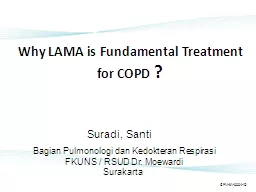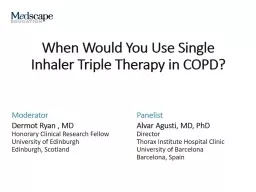PPT-Why LAMA is Fundamental Treatment
Author : test | Published Date : 2017-12-19
for COPD GPMSV0004ID Suradi Santi Bagian Pulmonologi dan Kedokteran Respirasi FKUNS RSUD Dr Moewardi Surakarta Central nervous system Vagus nerve Airway
Presentation Embed Code
Download Presentation
Download Presentation The PPT/PDF document "Why LAMA is Fundamental Treatment" is the property of its rightful owner. Permission is granted to download and print the materials on this website for personal, non-commercial use only, and to display it on your personal computer provided you do not modify the materials and that you retain all copyright notices contained in the materials. By downloading content from our website, you accept the terms of this agreement.
Why LAMA is Fundamental Treatment: Transcript
Download Rules Of Document
"Why LAMA is Fundamental Treatment"The content belongs to its owner. You may download and print it for personal use, without modification, and keep all copyright notices. By downloading, you agree to these terms.
Related Documents














